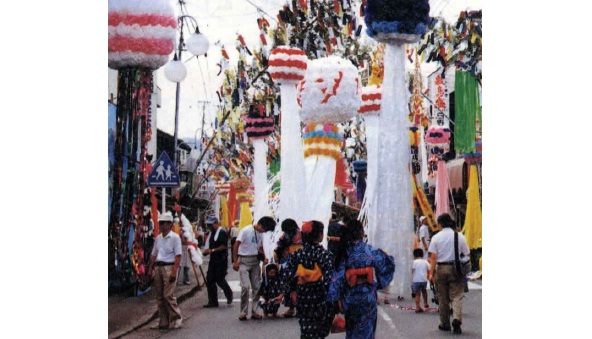By Denny Sargent
Photo by Rebecca Sargent
Every night people around the world, a variety of different countries and cultures, “wish upon a star” in the hope of getting their heart’s desire. Not only is this a common practice in Japan, but there is a festival dedicated to star-wishing celebrated all over the country. This festival is Tanabata.
Sometimes called Hoshi Matsuri (“Star Festival”), Tanabata is held in the Tokyo area at various times beginning July 7, but is also celebrated around Japan on different dates through mid-August. The reason for this is that the festival originally came from China and once based on the shifting lunar calendar.
When Japan adopted the “fixed” calendar, different localities made their own decisions as to when Tanabata would be celebrated. No matter when it’s held, the festival is one of the most colorful and interesting of all Japanese celebrations, one well worth the trouble to seek out and enjoy.
But what do stars have to do with all this?
Many festivals were originally born from certain myths or legends and this is true of the Star Festival. From the earliest times, stars were considered gods and tales of these gods were very widely believed, especially the legend of the “star-crossed lovers.”
Once upon a time there were two star-gods who were exceptionally beautiful and wise. The “Princess Weaver” (the star Vega) was the king’s daughter and a beautiful, accomplished weaver who was responsible for the royal cloth.
The divine Cowherd (the star Altair) was tending his flocks in the hills next to the palace one day when the Princess happened to gaze out the window. Their eyes locked and it was love at first sight They immediately ran to each other and, after a brief courtship, approached the king for his blessing, which he granted easily.
Unfortunately, problems soon developed. The two were so madly in love that the weaving and the herds were both neglected, not a good state of affairs. The king put his foot down and ordered the two to be separated by the “river of stars” (The Milky Way), except for one day a year when they could visit each other.
That one day is, as you’ve probably guessed, Tanabata! It’s the time each year when the star-gods Shokujo (the Princess) and Kengyu (the Cowherd) meet, crossing the Milky Way with the help of a bridge formed of loyal sparrows.
Knowing this myth, it’s easy to see why this festival has elements of romance, wish fulfillment and colorful artistry as part of its heritage. It also very likely has an interesting past as an ancient fertility festival as well.
Many of the complex ball-and-streamer Tanabata decorations seen today are said to represent stars, but you’ll also see some that depict cartoon characters, animals, dice and almost anything else that can be imagined.
Most Japanese today celebrate Tanabata about the same as their ancestors did, except that nowadays it is considered much more of a children’s festival. Tanabata festivities are extended to schools where children decorate their classrooms and offer poems and prayers for improved penmanship, along with more mundane wishes.
No matter what else, wishes and poems are still the key offerings for this holiday, and families still gather to write them down on beautiful strips of paper and tie them to bamboo branches. After these are suitably displayed, they are often ceremonially tossed into a river or the ocean.
Many families have their own bamboo poles for Tanabata, but those in Tokyo who are too busy to set one up can stop by almost any JR station. There you will find a Tanabata bamboo branch, strips of colored paper and a handy marker pen at your disposal. Feel free to make a wish and tie it to the branch. Any language is fine; the star-gods are very open-minded.
The best place to catch Tanabata festivities are in localities that make it their big holiday. In July, such towns in and near Tokyo as Ogawamachi, Hiratsuka and Fussa are good bets, though many easier-to-reach temples and shrines will have some sort of activity going on.
If you wish to travel farther afield, the most famous Tanabata festival is held in the city of Sendai from Aug. 6 to 8. Some other large-scale Tanabata festivals occurring at the same time are the Tanabata Etoro Matsuri in Yuzawa-shi, Akita Prefecture, thi Kenka and Kaijo Tanabata in Rikuzentakata-shi in Iwate, and the Matsumoto-no-Tanabata in Matsumoto-shi, Nagano Prefecture.
Whether you enjoy this festival in streets filled with streamers and dancers or in the privacy of your living room, it never hurts to make a wish upon a star, especially when you’re doing it along with millions of other Tanabata fans!









